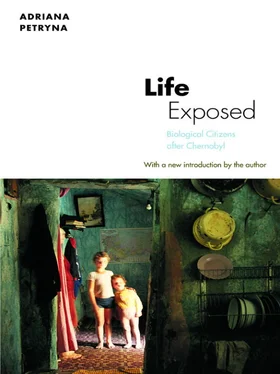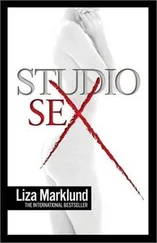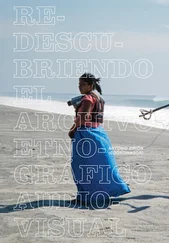In the Ukrainian context, efforts to assess and remediate the Chernobyl aftermath have contributed to social indeterminacy and novel formations of power. [22] The consequences of Chernobyl are an important example of what Ulrich Beck termed “manufactured uncertainties.” See Beck 1999.
Widespread unaccounted-for radiation exposures, state interventions and failures to intervene, expanding clinical and bureaucratic regimes, and market economic changes came to bear on a rational-technical course of illness and suffering. Suffering—its experiences and interpretations—has been patterned and realized within the rational-technical dynamics that were meant to remediate Chernobyl over time. At the same time, these dynamics have laid the groundwork for a “counter-politics” (Gordon 1991:5) that currently involves 7 percent of Ukraine’s population. Citizens have come to rely on available technologies, knowledge of symptoms, and legal procedures to gain political recognition and access to some form of welfare inclusion. Acutely aware of themselves as having lesser prospects for work and health in the new market economy, they inventoried those elements in their lives (measures, numbers, symptoms) that could be connected to a broader state, scientific, and bureaucratic history of error, mismanagement, and risk. The tighter the connections that could be drawn, the greater the probability of securing economic and social entitlement—at least in the short term. This undertaking of “illness-as-counter-politics” suggests that sufferers are aware of the way “politics shapes what they know and don’t know” (Proctor 1995:7) about their illnesses, and that they are willing to exploit these politics to limit further assaults on their well-being which they see as resulting from a collapsing state health system and loss of adequate legal protections. Inconsistencies related to the interpretation of radiation-related biological injury, together with the social and political uncertainties generated by Soviet interventions and current political-economic change, make the enormity of the affected population in Ukraine and its claims to injury at once plausible, ironic, and catastrophic.
• • •
What follows is an account of my field sites, methods, and the challenges of developing an ethnographic sensibility in this environment. I began my work in 1992, and during the summers of 1993 and 1994 I returned to Kyiv to continue to interview and work among resettled families, mothers of exposed children, and radiation-exposed workers. I followed them to public events in the Kyiv area and sat in on their meetings with state administrators at the Parliamentary Commission on Human Rights, where they negotiated the broadening of Chernobyl-related social and health care mandates. My initial data collection was oriented around these key questions: (1) How does the Ukrainian government administer individuals and populations claiming to be affected by radiation exposure? (2) What scientific knowledge and administrative policies are applied in the categorization of risk groups and in the formulation of compensation laws? (3) What scientific knowledge and political strategies are deployed by groups pressing for compensation and social justice on the basis of their Chernobyl condition? I carried out interviews with members of the country’s new Chernobyl Ministry, responsible among other things for attracting relief organizations and humanitarian aid; coordinating international efforts for financing and maintaining the Shelter unit; funding environmental monitoring and new building construction, such as homes for persons and families resettled from contaminated areas; coordinating the work of central and local state bodies and scientific and medical institutions; recommending policies for affected citizens; allocating finances for treatment and health care costs of affected populations; and distributing benefits and compensation. Heorhii Hotovshyts, the ministry’s first head, afforded me access to state legislators, administrators, Zone administrators, and local civil servants. I was permitted to read memos and internal reports outlining the dynamics of social response to the disaster; rules of hygiene for living in the zones; reports on patterns of media coverage; policy recommendations and medical criteria that Ministry of Health officials used in compensation decision making; and reports on emerging social psychological problems and methodological recommendations for rapid assessments of psychological status. Investigating how Chernobyl-related social mandates legitimated Ukrainian state-building processes, I collected data on Chernobyl welfare budgets and related them to national priorities for health and social protection spending in Ukraine, and I gathered information on how and on what scientific bases laws of compensation for Chernobyl sufferers had been established and expanded since Ukraine’s independence.
Along with my research at the level of state and civil society, I developed a brief social history of the scientific knowledge and technical experience that Soviet, American, and Ukrainian experts gained in the immediate and long-term management of Chernobyl. It became apparent that in order to do a fair analysis of the lived experience of Chernobyl, I had to do multisited work. That meant becoming scientifically literate—inquiring into the circulation and assimilation of scientific knowledge at national, international, and local levels, as well as exploring their tensions. I conducted interviews with key scientific and political players in both Kyiv and Moscow, comparing scientific norms of biological risk and safety in the Soviet and post-Soviet administrations of the aftermath. I also looked into expert claims at the International Atomic Energy Agency and at government laboratories in the United States. At Lawrence Berkeley Laboratory (whose scientific work is unrelated to Chernobyl issues), I learned some of the basic radiobiological techniques for assessing the biological impact of radiation at the cellular and DNA levels. But as one radiation scientist told me, the difference between this manipulable animal environment and populationwide exposures to low-dose radiation remains a “black box.” Though causal links between high doses of radiation and human biological effects have been well-established, the same cannot be said for continuous human exposure to low doses. It is no surprise that health predictions made by international health experts have often contradicted people’s lived experience. The calculus of cost and criteria of assessment of injury are, by definition, open-ended and contestable.
In the absence of agreed-upon standards, a new social and political arena opened in Ukraine. I learned in my long-term work with civil servants of the Chernobyl welfare apparatus that disputes over the scope of injury of this disaster, and over how to model it, continue to influence policy, social mobilizations, and not least the very nature of the course of illnesses in the affected populations I worked with. From the field I could also observe that different scientific approaches (psychometric versus biological, laboratory versus field-based research), different funding priorities, and different senses of urgency concerning the unknown health effects of the disaster were not simply at odds with each other; nor were they simply waiting to be assessed for their suitability or unsuitability. Their confrontation and juxtaposition engendered a new environment—or, more precisely, a political economy of claims around radiation illness. Developing alongside the new scientific, biomedical, and legal institutions promoting “safe living” in Ukraine was another social phenomenon that caught my attention. It was the boom of civic organizations called fondy (funds) that administered international charity and the compensation claims of the Zone workers. Also, since these more than five hundred funds are tax-exempt, they have sparked a large informal economy based on imports of a variety of goods, including pharmaceuticals, cars, foodstuffs, and so on.
Читать дальше












